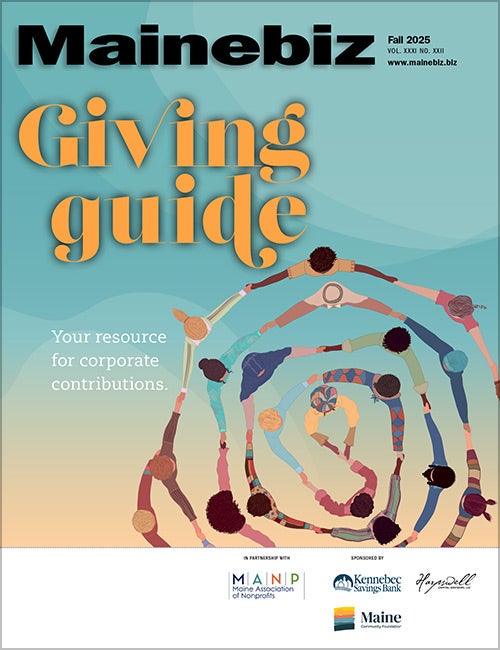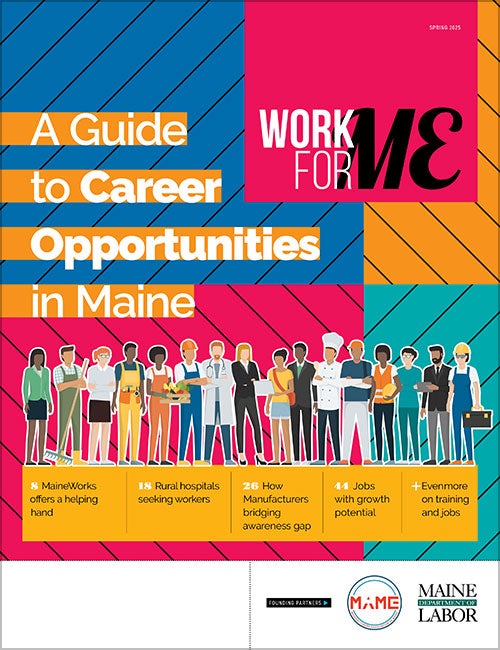Processing Your Payment
Please do not leave this page until complete. This can take a few moments.
- News
-
Editions
View Digital Editions
Biweekly Issues
- December 1, 2025
- Nov. 17, 2025
- November 03, 2025
- October 20, 2025
- October 6, 2025
- September 22, 2025
- + More
Special Editions
- Lists
- Viewpoints
-
Our Events
Event Info
Award Honorees
- Calendar
- Biz Marketplace
COMMENTARY: Are the kids alright? | Why Maine businesses should care about comprehensive youth financial education
Education and Maine Jumpstart Coalition; Governmental and public affairs manager, Maine Credit Union League
If Maine is to remain competitive in today's global economy, it will be increasingly important to provide our children with a comprehensive youth financial education program ˆ and the results of a recent survey of the status of economic and financial education nationwide show how serious the need is. Maine's ability to integrate personal finance principles and concepts into our educational curriculum will have a direct correlation with our long-term economic prosperity and growth.
How does having a financially savvy child affect whether Maine's economy is successful? A child who understands topics such as budgets, money management, savings and credit is infinitely more likely to become a financially savvy adult. In an entrepreneurial state such as Maine, where small businesses play a vital role in our economic growth, a child who grows up with a clear knowledge of economics and finance can parlay that background into a productive career as business owner. That ability would give Maine a distinct advantage over other states whose children have less exposure to ˆ and awareness of ˆ managing money, building capital and all of the other necessities associated with successful businesses.
In its fourth biennial survey, the National Council on Economic Education found that 17 states require the teaching of such courses as high school graduation requirements; among those states, California, Florida, Texas and New York alone represent one-third of the nation's population. Some 38 states, including Maine, integrate economics and personal finance into their state standards. Seven states require a specific financial education course for high school students, beyond a more general economics requirement.
The National Jumpstart Coalition for Personal Financial Literacy also published findings on the state of financial literacy in the nation. Its most recent report in 2004 offers the following analysis: On average, students who participated in the 2004 survey answered 52.3% of the questions correctly. That score is up from 50.2% in 2002 and 51.9% in 2000. However, it should be noted that 65.5% of students still failed this exam, based upon a typical scale used by many public schools across the country; in addition, the modest gains of 2004 did not match the 1997 achievement of 57.3%.
Survey questions were divided into four categories: income, money management, saving and spending. Students did a far better job of answering questions about income (getting 62.9% of these questions right) and spending (55.4%) than they did of answering those about money management and saving (45.4% and 41.0%, respectively).
And students who were required to attend money management courses in high school fared better than others. Specifically, the students attending required classes scored better (with an average score of 54.1%) than those at schools where it was required only for some students (50.5%) and those where money management classes were electives (52.7%).
Parental involvement also continued to play a significant role in the financial education of young people. The majority of participants ˆ 58.3% ˆ said they learn most of their money management skills at home. That compares to 19.5% who said they learn such skills at school, and 17.6% who cited their own experience.
As schools struggle to meet the demands of the No Child Left Behind Act and the ongoing requirements of Maine Learning Results, it becomes increasingly obvious that those subject areas that are not required or that are not formally assessed will naturally fall behind those that are. Maine's local assessments in economics do make a difference, and the Maine Council on Economic Education is working with schools to develop creative and effective assessments in economics and personal finance. But it remains difficult when these areas are not in the core assessments required by the state.
Several Maine businesses have already stepped forward to help improve the financial literacy of Maine students. Working with the Maine Council on Economic Education, Maine's credit unions have organized regional financial education fairs for high schools in the greater Lewiston and Bangor areas and have developed partnership programs with individual schools. MBNA has funded an exemplary program at Camden Hills Area High School, Kennebunk Savings Bank has promoted an extensive project in SAD 71 and the Bangor Savings Bank Foundation has funded a survey of financial education programs in Maine high schools that is underway now.
These organizations all have a direct stake in the economic success of Maine and its residents. Having children who can understand personal finance and money management principles before they become adults helps Maine become a stronger and more fiscally responsible state. For credit unions, these efforts have not only helped to foster relationships with children at an early age, but they've also helped to build awareness about the importance and value of youth financial education. As Maine's economy continues to diversify, our children must have a solid understanding of concepts such as balancing a checkbook, budgeting and making choices ˆ and sacrifices ˆ to remain financially successful as adults.
But more can and should be done. As business leaders and educators, we must continue to explore new partnerships to achieve the goal of helping all our children become fiscally responsible consumers. Achieving this goal will pay lifelong dividends ˆ and that is a rate of return too good to pass up.
Mainebiz web partners

The Giving Guide
The Giving Guide helps nonprofits have the opportunity to showcase and differentiate their organizations so that businesses better understand how they can contribute to a nonprofit’s mission and work.
Learn More
Work for ME
Work for ME is a workforce development tool to help Maine’s employers target Maine’s emerging workforce. Work for ME highlights each industry, its impact on Maine’s economy, the jobs available to entry-level workers, the training and education needed to get a career started.
Learn More
Groundbreaking Maine
Whether you’re a developer, financer, architect, or industry enthusiast, Groundbreaking Maine is crafted to be your go-to source for valuable insights in Maine’s real estate and construction community.
Learn more-
The Giving Guide
The Giving Guide helps nonprofits have the opportunity to showcase and differentiate their organizations so that businesses better understand how they can contribute to a nonprofit’s mission and work.
-
Work for ME
Work for ME is a workforce development tool to help Maine’s employers target Maine’s emerging workforce. Work for ME highlights each industry, its impact on Maine’s economy, the jobs available to entry-level workers, the training and education needed to get a career started.
-
Groundbreaking Maine
Whether you’re a developer, financer, architect, or industry enthusiast, Groundbreaking Maine is crafted to be your go-to source for valuable insights in Maine’s real estate and construction community.
ABOUT
NEW ENGLAND BUSINESS MEDIA SITES
No articles left
Get access now
In order to use this feature, we need some information from you. You can also login or register for a free account.
By clicking submit you are agreeing to our cookie usage and Privacy Policy
Already have an account? Login
Already have an account? Login
Want to create an account? Register
Get access now
In order to use this feature, we need some information from you. You can also login or register for a free account.
By clicking submit you are agreeing to our cookie usage and Privacy Policy
Already have an account? Login
Already have an account? Login
Want to create an account? Register







Comments